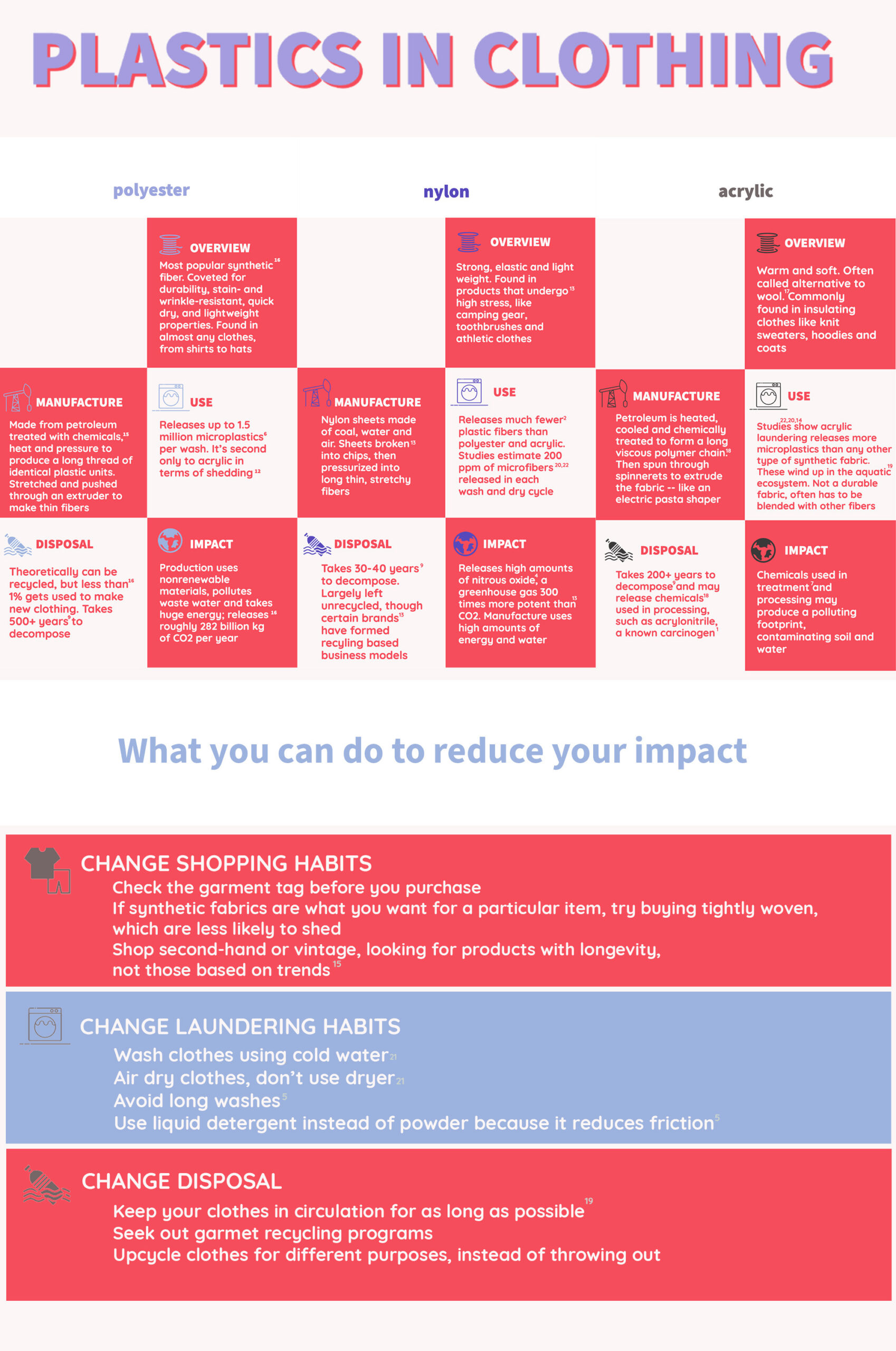A look into the plastic inside your clothes
An infographic diving into three types of plastic-based fabrics and how they may be affecting our environment
Maiya Focht • September 9, 2022

When viewed under a microscope, the woven bits of plastic that make up fabrics like nylon are easier to see. [Credit: Alexander Klepnev | CC BY 4.0]
It turns out my wardrobe has quite a lot in common with the Polly Pocket clothes I used to chew on as a kid: They both are made of a lot of plastic. In a quest to understand more about how our use of plastic is affecting the world, I wanted to figure out just exactly how the clothes I wear contribute to that.
I discovered that many of the stretchy, durable and soft fabrics that make up everything from my underwear to my winter jacket are made from synthetic fabrics. These fabrics, like other plastics, are made from fossil fuels. It’s estimated that 342 million barrels of oil are put towards their production every year.
In order to break that massive production into bite-size pieces, I took a look at three synthetic fabric types, though there are at least seven more in common circulation. The infographic below examines their manufacture, use and disposal and demonstrates how you may be interacting with and furthering plastic use right in your own closet.
But while considering all that, keep in mind that natural textiles — like cotton, flax, wool and silk — have their issues too. The production of cotton, for example, uses massive amounts of water; it’s estimated that it takes 2,700 liters of water to produce one cotton T-shirt. Pesticides and other agents used in the farming and manufacturing process can also contribute to groundwater pollution, according to the World Wildlife Fund.
Zoom in for more info about plastics below!

References
- “Acrylonitrile.” The National Institute for Occupational Safety and Health (NIOSH). https://www.cdc.gov/niosh/npg/npgd0014.html
- “Almost 13,000 Tons of microfibers released Into European Waters Every Year.” Ocean Clean Wash by Plastic Soup Foundation, https://www.oceancleanwash.org/2020/06/almost-13000-tons-of-microfibers-released-into-european-waters-every-year/
- “A New Textiles Economy: Redesigning fashion’s future.” Ellen MacArthur Foundation, https://ellenmacarthurfoundation.org/a-new-textiles-economy
- “Budget 2021-22: How sustainable is push for nylon?” Down To Earth, https://www.downtoearth.org.in/news/environment/budget-2021-22-how-sustainable-is-push-for-nylon–75351
- “Consumers.” Ocean Clean Wash by Plastic Soup Foundation, https://www.oceancleanwash.org/solutions/solutions-for-consumers/
- De Falco, F., Di Pace, E., Cocca, M. et al. “The contribution of washing processes of synthetic clothes to microplastic pollution.” Sci Rep 9, 6633 (2019). https://doi.org/10.1038/s41598-019-43023-x
- “Environmental Impact of Acrylic Fabric (And Is It Recyclable?)” Conserve Energy Future, https://www.conserve-energy-future.com/environmental-impact-acrylic-fabric.php
- “Fossil fashion.” Changing Markets Foundation, https://changingmarkets.org/portfolio/fossil-fashion/
- “How long does it take to decompose?” Twin Enviro Services, https://twinenviro.com/2019/10/11/how-long-does-it-take-to-decompose/
- Imogen E. Napper, Richard C. Thompson, Release of synthetic microplastic plastic fibres from domestic washing machines: Effects of fabric type and washing conditions, Marine Pollution Bulletin, Volume 112, Issues 1–2, 2016, Pages 39-45, ISSN 0025-326X, https://doi.org/10.1016/j.marpolbul.2016.09.025.
- Johnny Gasperi, Stephanie L. Wright, Rachid Dris, France Collard, Corinne Mandin, Mohamed Guerrouache, Valérie Langlois, Frank J. Kelly, Bruno Tassin, Microplastics in air: Are we breathing it in?, Current Opinion in Environmental Science & Health, Volume 1, 2018, Pages 1-5, ISSN 2468-5844, https://doi.org/10.1016/j.coesh.2017.10.002.
- Mark Anthony Browne, Phillip Crump, Stewart J. Niven, Emma Teuten, Andrew Tonkin, Tamara Galloway, and Richard Thompson. “Accumulation of Microplastic on Shorelines Worldwide: Sources and Sinks.”Environmental Science & Technology, 2011 45 (21), 9175-9179 DOI: 10.1021/es201811
- “Material Guide: How Sustainable is Nylon?” Good On You, https://goodonyou.eco/material-guide-nylon/
- “More than 700,000 Plastic Fibers for every 6 Kilos of Laundry.” Plastic Soup Foundation, https://www.plasticsoupfoundation.org/en/2016/10/more-than-700000-plastic-fibers-for-every-6-kilos-laundry/
- Orenstein, Charlotte. “Renewal: Engaging Consumers in Sustainable Fashion.” 2021. https://issuu.com/charlieorenstein/docs/thesis_issuu
- “Polyester- Materials Index.” The Council of Fashion Designers of America, Inc, https://cfda.com/resources/materials/detail/polyester
- “What Is Acrylic Fabric? The Only Guide You Will EVER Need.” Silver Bobbin, https://silverbobbin.com/what-is-acrylic-fabric/
- “What Is Acrylic Fabric?” Natural Clothing, https://www.naturalclothing.com/what-is-acrylic-fabric/
- “What to Do About Microfibres in Clothing.” Good on You, https://goodonyou.eco/what-to-do-about-microfibres/#:~:text=In%202020%2C%20we%20found%20out,same%20as%20those%20from%20washing.
- Choi S, Kim J, Kwon M. The Effect of the Physical and Chemical Properties of Synthetic Fabrics on the Release of Microplastics during Washing and Drying. Polymers. 2022; 14(16):3384. https://doi.org/10.3390/polym14163384
- Focht M, “Fighting Fast Fashion.”Scienceline, https://scienceline.org/2022/02/fighting-fast-fashion/
- Choi S, Kwon M, Park M-J, Kim J. Characterization of Microplastics Released Based on Polyester Fabric Construction during Washing and Drying. Polymers. 2021; 13(24):4277. https://doi.org/10.3390/polym13244277